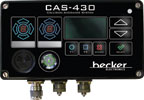Becker's collision avoidance technology
March 2011
Sensors & Transducers

Collision avoidance systems (CAS) developed for the mining sector by Becker Electronics, prevent fatalities, injuries, damage and downtime that can result from the operation of vehicles in the proximity of personnel, either on the surface or underground.
These modular systems, which range from a simple, low-cost single technology to an integrated multitechnological system, encompass all aspects of advanced mining communications and technology.
Becker’s latest patented tri-technology CAS, with four proximity warning zones, has been designed to overcome the limitations of existing systems and can even bring the mine vehicle to a complete stop should this be necessary.
“This reliable system, which is installed in various mine vehicles and cap lamp battery packs, acts as an early warning indicator to both vehicle operators and pedestrians, playing a vital role in enhancing safety,” says Albert Bower, managing director of Becker Electronics. “CAS is a very necessary safety system on the mines, particularly underground, because in this harsh environment it is impossible for a vehicle operator always to be fully aware of other miners and vehicles in the immediate area.”
The collision and personnel avoidance systems consist of personnel and vehicle tags and the machine mounted devices which detect them. (Higher end-tags warn personnel of an approaching vehicle). These products may be utilised as a simple standalone or complete system and can be deployed using a phased approach to minimise initial capital outlay.
The new CAS-400 series receiver provides audible voice annunciation (customisable in different languages) and visual warning proportional to the position of the threat. An onboard buffer enables authorised personnel to download daily movement details, either physically, or via a wireless network like a leaky feeder system.
Miners are cautioned when they get too close to a vehicle by means of a flashing light and buzzer on the cap lamp. The number of flashes, which is limited to five, indicates the number of vehicles in a miner’s vicinity. The detecting range can be set according to specific requirements. The combination warns personnel of machines, machines of personnel and machines of other machines. A further advantage of the new multiple technology approach is that mines now have the flexibility to monitor both slow and fast moving equipment on the surface and underground using one system.
For more information contact Albert Bower, Becker Electronics, +27 (0)11 801 5900, [email protected], www.za.becker-mining.com
Further reading:
Adjustable proximity sensor with five metre range
Sensors & Transducers
The Telco line of photo-electric eyes have the accuracy and reliability you need.
Read more...
Food safety – a matter of weight
Sensors & Transducers
Weighing systems play a key role in ensuring product quality in food production, complying with legal requirements and avoiding product recalls. The Minebea Intec MiNexx portfolio has been specially developed to meet these requirements.
Read more...
Telco sensors in the paper and pulp industry
Sensors & Transducers
The paper and pulp industry poses a major problem for most photoelectric sensors. Telco Sensors has overcome this with its powerful and high-performance photoelectric sensors, ensuring penetration of thick and harsh pollution while guaranteeing reliable detection.
Read more...
Leaders in sensor technology
Sensors & Transducers
A new addition to the Telco Sensors range is the adjustable Proximity sensor, with a range up to 5 metres.
Read more...
Cutting-edge sensor technology
Endress+Hauser South Africa
Sensors & Transducers
The advantage of Endress+Hauser’s Memosens technology is that digitised measured values and sensor information are transmitted via a non-contact connection from the sensor to the cable, and as a digital signal to the transmitter.
Read more...
Miniature inductive sensors
ifm - South Africa
Sensors & Transducers
The inductive IY/IZ type sensors from ifm are used in various industrial areas where space is limited.
Read more...
The expanding role of 3D cameras in industrial quality control
TANDM Technologies
Sensors & Transducers
Across factory floors, warehouses, mines and research centres worldwide, computer vision paired with 3D camera technology is revolutionising quality control.
Read more...
PDS implementation on mines
Sensors & Transducers
Level 9 vehicle intervention for collision avoidance has been mandatory on South African mines since 2022, yet the effective roll-out of proximity detection systems remains slower than expected. This is not due to the technical limitations of integration but to operational readiness on site.
Read more...
Monitoring analogue process values
ifm - South Africa
Sensors & Transducers
Everywhere in industry, electronic sensors are used to detect process values such as temperature, pressure or flow. Process value monitoring often takes place directly in the sensor.
Read more...
Protecting buildings’ embodied carbon with retrofitted systems
Schneider Electric South Africa
Sensors & Transducers
The World Economic Forum has said that around 80% of the buildings in existence will still be around in 2050; it is therefore essential that in order to combat climate change we retrofit them for energy efficiency.
Read more...


